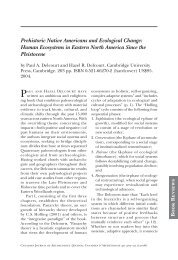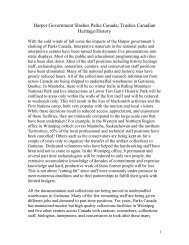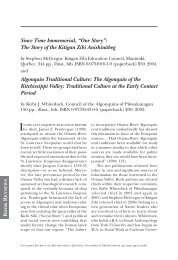aménagement hydroélectrique, le travail archéologique initié par la Nationd'Okawamithikani, en collaboration avec le Musée du Manitoba, a contribué à faireavancer notre interprétation et l'i<strong>de</strong>ntification <strong>de</strong> sites en forêt boréale. Cette présentationcompare les recherches archéologiques réalisées sur le Fleuve Churchill <strong>de</strong>puis 1969 et lerôle <strong>de</strong>s communautés locales dans la collecte <strong>de</strong> données concernant leur histoire.Burke, A. 1 , Guiducci, A., Izquierdo, M., Levavasseur, G.,1 . Départementd’anthropologie, Université <strong>de</strong> Montréal Mo<strong>de</strong>lling climate variability during the LastGlacial Maximum and its impact on human population expansion (26) The “Grouped’Étu<strong>de</strong> <strong>de</strong>s Dispersions d’Hominidés” was formed in 2008 to investigate the impact ofenvironmental change on the pattern of hominid dispersals. In this research, we use ahigh-resolution climate simulation to test the impact of climate variability on thedistribution of human populations in the Iberian Peninsula during the Late GlacialMaximum. The effects of climate change on regional environments during the onset offull glacial conditions in the Iberian Peninsula is a hotly <strong>de</strong>bated topic, our research helpsshed light on this <strong>de</strong>bate as well as exploring the relationship between climate variabilityand population dynamics during the early phases of the mo<strong>de</strong>rn human colonisation ofEurope.Burke, Adrian L. (Université <strong>de</strong> Montréal) Trois-Rivières et Bécancour à la fin <strong>de</strong>l’Archaïque : résultats du projet triennal <strong>de</strong> l’Université <strong>de</strong> Montréal (29) La région <strong>de</strong>Trois-Rivières et Bécancour a toujours été un lieu d’interaction et d’échanges pour lespeuples amérindiens. Vers la fin <strong>de</strong> l’Archaïque et le début du Sylvicole (env. 4000-2500BP), cette région <strong>de</strong>vient particulièrement courue ou achalandée. Les sites archéologiquessont nombreux et les matériaux indiquent <strong>de</strong>s liens avec plusieurs régions à travers legrand Nord-Est. Comment expliquer l’importance <strong>de</strong> la région <strong>de</strong> Trois-Rivières etBécancour pendant l’Archaïque terminal et le Sylvicole inférieur? Sa positiongéographique peut sans doute expliquer en partie cette popularité. Cependant, d’autresaspects environnementaux et sociopolitiques rentrent en jeu aussi. Un projet <strong>de</strong> recherchemené par les archéologues <strong>de</strong> l’Université <strong>de</strong> Montréal et étalé sur trois ans (2009-2011) aabordé ces questions avec <strong>de</strong>s campagnes <strong>de</strong> prospection, sondages et fouillesarchéologiques ainsi qu’une campagne <strong>de</strong> carottage dans <strong>de</strong>ux lacs <strong>de</strong> la région. Nousprésentons les premiers résultats <strong>de</strong> ces recherches et nos interprétations.Burns, Mélissa (Memorial University) The Taskscape of an 18th-century FrenchSeasonal Fishing Station on Newfoundland's Petit Nord (8) From the early 1500s,migratory fishermen from Brittany and Normandy pursued a seasonal salt-cod fishery onthe Petit Nord, in northern Newfoundland. Returning every summer, year after year,French fishermen acquired the knowledge nee<strong>de</strong>d to tame and <strong>de</strong>velop the Petit Nord.This small-scale, exclusively male society was well adapted to the Newfoundlandlandscape. By 1700, fishermen had significantly modified their environment by clearingforests, fishing cod, hunting birds and building paths, cookrooms, fishing stages, sheltersand such. Through a case study of the fishing room Champs Paya, this paper will discussthe daily life of seasonal fishermen in northern Newfoundland in the 18 th century. Ataskscape analysis suggests that this male society treated the Petit Nord as part of theBreton maritime cultural landscape, even if this was, geographically, part of anothercontinent.
Cadieux, Nicolas, Jean-Christophe Ouellet, Hélène Buteau (Archéotec inc.) Lamodélisation tridimensionnelle et la représentation <strong>de</strong>s données archéologiques :perspectives et prospectives (18) La modélisation en trois dimensions <strong>de</strong> sitesarchéologiques constitue un nouvel outil qui s’offre aux archéologues pour représentervisuellement les données archéologiques obtenues sur le terrain. Ce type <strong>de</strong> représentationa été appliqué à un ensemble <strong>de</strong> données provenant du site EjFt-003. C’est par lacombinaison <strong>de</strong>s données topographiques, archéologiques et ethnographiques qu’ont étéreconstruits l’environnement et les activités réalisées par les groupes préhistoriques donttémoignent les données archéologiques récoltées sur le site. Au-<strong>de</strong>là d’une simplereconstruction visuelle, l’application <strong>de</strong> cette métho<strong>de</strong> <strong>de</strong> représentation permet <strong>de</strong> rendrecompte, avec un grand souci <strong>de</strong> réalisme et d’acuité, <strong>de</strong> certaines facettes <strong>de</strong> la vie <strong>de</strong>sgroupes préhistoriques étudiés. Certains résultats issus <strong>de</strong> cet exercice sont présentés icidans le but <strong>de</strong> stimuler les discussions sur l’utilité et le potentiel <strong>de</strong> ce type <strong>de</strong> métho<strong>de</strong>pour l’interprétation et la diffusion <strong>de</strong>s données archéologiques. - Tridimensional imagingand the representation of archaeological data: perspectives and prospectives. 3Dmo<strong>de</strong>ling of archaeological site offers archaeologists a new and stimulating way torepresent data gathered in the field. This type of 3D representation has been used tovisualize archaeological data from the site EjFt-003. By combining topographical,archaeological and ethnographical information, we have reconstructed the environmentand the activities conducted by the prehistoric groups. The resulting 3D mo<strong>de</strong>l offersmore than just a pretty picture. This method allows us to visualize with great <strong>de</strong>tail andveracity the daily life of the studied groups. Results of this exercise are presented here inor<strong>de</strong>r to stimulate <strong>de</strong>bate and discussion on the potential and utility of the application ofthis type of method upon interpretation and diffusion of archaeological data.Caldwell, Megan (University of Alberta), Dana Lepofsky (Simon Fraser University),and Michelle Washington (Sliammon First Nation) Fish and Fishing in Tla'aminTraditional Territory – From 3,000 years ago until the present (14) Fish and shellfish arecentral to Tla’amin cultural i<strong>de</strong>ntity. In the past, many species of marine fish and shellfishwere managed throughout Tla’amin traditional territory. Our research over the pastseveral years has focused on i<strong>de</strong>ntifying intertidal management features (fish traps,cleared clam beaches) on the landscape, and associating these features with both otherarchaeological remains (village and campsite locations, faunal remains) and the specificlocal ecological knowledge held by Tla’amin community members. We present thefindings of this research, with a focus on the specific means by which Tla’amin peoplemanaged fish and shellfish resources in the past – the intertidal management features,tenure systems and social conventions that allowed for management and harvest of avariety of taxa over the last 3,000+ years – and will conclu<strong>de</strong> with a discussion on thecurrent state of fish and shellfish resources in Tla’amin traditional territory.Campbell, Jennifer (Archaeology Centre, University of Toronto/LakeheadUniversity) I<strong>de</strong>ntity, Subjectivity, and the <strong>Canadian</strong> Archaeologist Abroad (3)Anthropological archaeologists often examine national i<strong>de</strong>ntity programs that use historyto legitimize geo-political engagements; focusing on the colonial legacy and the lastingentanglements of the past colonial-subject with the post-post-colonial-subjectivity. In thispaper I explore the impacts of researcher subjectivity, in particular the subjectivity of<strong>Canadian</strong> trained anthropological archaeologists, on the interpretations we draw about the
- Page 1 and 2: RÉSUMÉS / ABSTRACTSPar ordre alph
- Page 3 and 4: glyphs in images for posterity have
- Page 5 and 6: Balac, Anne-Marie (Ministère de la
- Page 8: Bergeron, André (Centre de conserv
- Page 12 and 13: forme traditionnelle imprimée ou d
- Page 14: after learning about what happened
- Page 19: known in the area, both historic an
- Page 22 and 23: Comeau, Jennifer (Memorial Universi
- Page 24 and 25: in single households. Given that th
- Page 27 and 28: Crompton, Amanda (Memorial Universi
- Page 29 and 30: describe the spatial extent of the
- Page 31 and 32: Columbia. Although dogs are not a d
- Page 33 and 34: planification des fouilles archéol
- Page 35 and 36: synthèse des données biophysiques
- Page 37 and 38: Ellis, Christopher (University of W
- Page 39 and 40: ever made in an archaeological site
- Page 41 and 42: qui occupait déjà l’esprit des
- Page 43 and 44: impliqués dans les pêcheries et l
- Page 45 and 46: préhispaniques. Parmi ces camélid
- Page 47 and 48: archaeometrists these days is a tec
- Page 49 and 50: patches undertaken to identify the
- Page 51 and 52: integration of feature, artifact an
- Page 53 and 54: l’appellation crie désignant les
- Page 55 and 56: order to ensure there was no damage
- Page 57 and 58: in 1851 as a market and destroyed i
- Page 59 and 60: devait tenir compte des grands prin
- Page 61 and 62: elusive has been a consistent way o
- Page 63 and 64: driving forces in Québec archaeolo
- Page 65 and 66:
Ly, Yvonne (Archéotec inc.) Essai
- Page 67 and 68:
contribution de Google Earth à la
- Page 69 and 70:
to its taphonomic agent. These obse
- Page 71 and 72:
Monchot, Hervé (Université Paris
- Page 73 and 74:
horticulturalists. Broad-bladed bif
- Page 75 and 76:
Oetelaar, Gerald (University of Cal
- Page 77 and 78:
Paxton-MacRae, Mark (Western Herita
- Page 79 and 80:
19 th and 20 th centuries. Old-grow
- Page 81 and 82:
while deer, particularly white tail
- Page 83 and 84:
Rankin, Lisa K. (Memorial Universit
- Page 85 and 86:
Robinson IV, Francis (University at
- Page 87 and 88:
Royer, Martin (Ethnoscop inc.) Inve
- Page 89 and 90:
Sifontes, Sarah (York University) D
- Page 91 and 92:
isotopique par spectrométrie de ma
- Page 93 and 94:
quarries have been discovered and e
- Page 95 and 96:
aux XVII e et XVIII e siècles (25)
- Page 97 and 98:
last rapids of St. Laurence river.
- Page 99 and 100:
Woods, Audrey (Université de Montr
- Page 101 and 102:
theorizing material culture, much o








